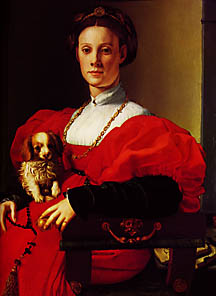
This italian portrait, by Bronzino, shows a mode of dress quite different from most people's concept of "Tudor Costume". This illustrates the wide disparity present at the beginning of the 16th century between various national forms of dress; spanish dress was quite different from French dress, which itself was very different from German or Eastern European modes of fashion.
The red satin dress worn by this woman does have the flat front reminiscent of Holbein's Sketches of an Unknown Woman and his Portrait of Jane Seymour, but there its similarity to northern european dress ends. There is none of the super-elaborate jewelling or rich brocade popular with the portraits of English nobility; rather, the dress is accented by the simplicity of the cut, which allows the viewer to appreciate the color and richness of the fabric.
Instead of the narrow sleeves with cuffs, or, alternately, the widely flared oversleeves showing decorated undersleeves, this dress exhibits lavishly puffed, elbow-length oversleeves and the black, wrist-length sleeve of an underdress beneath it. The waistline, rather than resting at the natural level of the waist, is raised to a few inches below the bust; and the skirt, lacking the rigidity of a spanish farthingale to hold it out in a bell shape, gracefully follows the line of the chair as it flows down to the floor.
The headdress--perhaps hairstyle would be a better word--worn by this woman is also radically different from that of northern women; at this time, the large gable hood was popular in Northern Europe, and was worn for many formal portraits. Most portraits and pictures showing women in 1530s Flanders, England, and other Northern countries show them wearing some form of head-covering.
Not so in Italy. This woman wears her hair twisted and fastened into a ring arching over the crown of her head, a hairstyle found in other Italian portraits of this period. On the whole, Italian and Spanish portraits of the early 1500s display more hair, and therefore more complicated hairstyles, than those of English, Flemish, and northern european origin.
This lady is also wearing a closely gathered smock which fastens at the neck. This is a different style from the smocks worn by Englishwomen at this time; most Tudor smocks were low-necked, and it was not until the 1550s or later that high-necked, gathered smocks came into common use with English women.